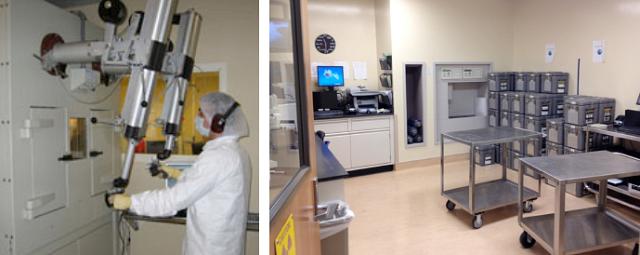
CQCI Radiochemistry - Radiopharmacy
The molecular imaging radiopharmacy at Huntsman Cancer Institute (HCI) is located in the Center for Quantitative Cancer Imaging (CQCI) cyclotron radiochemistry laboratory. The radiochemistry laboratory is a cGMP facility (CFR Title 21 Part 212) licensed by the FDA for PET drug manufacturing. The radiochemistry laboratory is also licensed by the State of Utah as a Class C commercial pharmacy manufacturer. The radiopharmacy itself was first licensed by the State of Utah as a Class B pharmacy in September 2010.
An onsite PET radiopharmacy allows for the distribution of PET radiopharmaceuticals compounded specifically for patients in hospitals and clinics throughout the Intermountain region. The radiopharmacy also takes on the responsibility for all of the regulatory and quality assurance (QA) oversight of all FDA-approved radiopharmaceuticals. Compliance with the Radioactive Material License issued by the Utah Division of Radiation Control (UDRC) is also maintained through the radiopharmacy.
The radiopharmacy staff is composed of three nuclear pharmacists. Isaiah Springer serves as the pharmacist in charge (PIC) and oversees regulatory and quality assurance (QA lead) for all FDA-approved radiopharmaceuticals. The other nuclear pharmacists function in various capacities within the CQCI to assure regulatory compliance of our radiopharmaceuticals. Other staff members, such as the radiochemists, have been trained to perform several pharmacy-related tasks and are able to assist the nuclear pharmacist in the day-to-day operation of the pharmacy. All staff members are supervised by the pharmacist in charge in accordance with rules set forth by the State Board of Pharmacy in the Division of Occupational and Professional Licensing (DOPL). A radiopharmacist is on site during normal business hours to supervise pharmacy staff during the day-to-day operations.
Radiopharmacists are fully trained as Authorized Users in the handling of radioactive drugs for medical use and, as such, are certified Authorized Nuclear Pharmacists (ANP) by the U.S. Nuclear Regulatory Commission (NRC). As the on-site Authorized Users in a commercial nuclear pharmacy, the pharmacists have the responsibility to prepare or supervise the preparation of radioactive drugs for medical use (NUREG–1556 8.7.2). The on-site RSO, Jeffrey Yap, PhD, oversees safety, security, and control of radioactive material as well as compliance with regulations (NUREG-1556 8.7.1). In order to practice pharmacy, radiopharmacists must also possess a pharmacist license in the State of Utah.
The compounding and dispensing of PET radiopharmaceuticals takes place under United States Pharmacopeia (USP) <797>, <823>, and cGMP conditions while inside a Clean Room. The PET pharmacy staff consists of highly trained individuals who adhere to strict aseptic guidelines when preparing and dispensing radiopharmaceuticals for patient use. The Clean Room is a Class 10,000 (ISO 7) environment and the compounding and dispensing of radiopharmaceuticals is performed inside a laminar airflow hood that is Class 100 (ISO 5) certified. Exhaust from this area is ventilated through a dedicated duct system with filters and radiation monitors.
The radiopharmacy staff receive training in the shipping of radioactive material according to U.S. Department of Transportation regulations. Radiopharmacists must also follow the requirements for the University of Utah’s radioactive materials license. Training for shipping of radioactive material is conducted by the Radiological Health Department of the University of Utah, which authorizes the radiopharmacy to ship radioactive material.
Our pharmacy’s computer software is called the BioRx Nuclear Pharmacy Management System. This program helps manage pharmacy operations. It is primarily used for keeping record of prescription orders, radioactive shipments, preparation and dispensing of the radiopharmaceuticals, and health physics data related to sealed source inventory, wipe tests, and surveys.
Prescription files are stored electronically in our pharmacy software management system. Faxed prescriptions and orders received by phone are filed and kept on site for five years. Rx numbers are automatically generated by the pharmacy’s system and each prescription label contains all the required information applicable to pharmacy law.
Contact Us
Jeffrey Yap, PhD
jeffrey.yap@hci.utah.edu
801-213-5650
